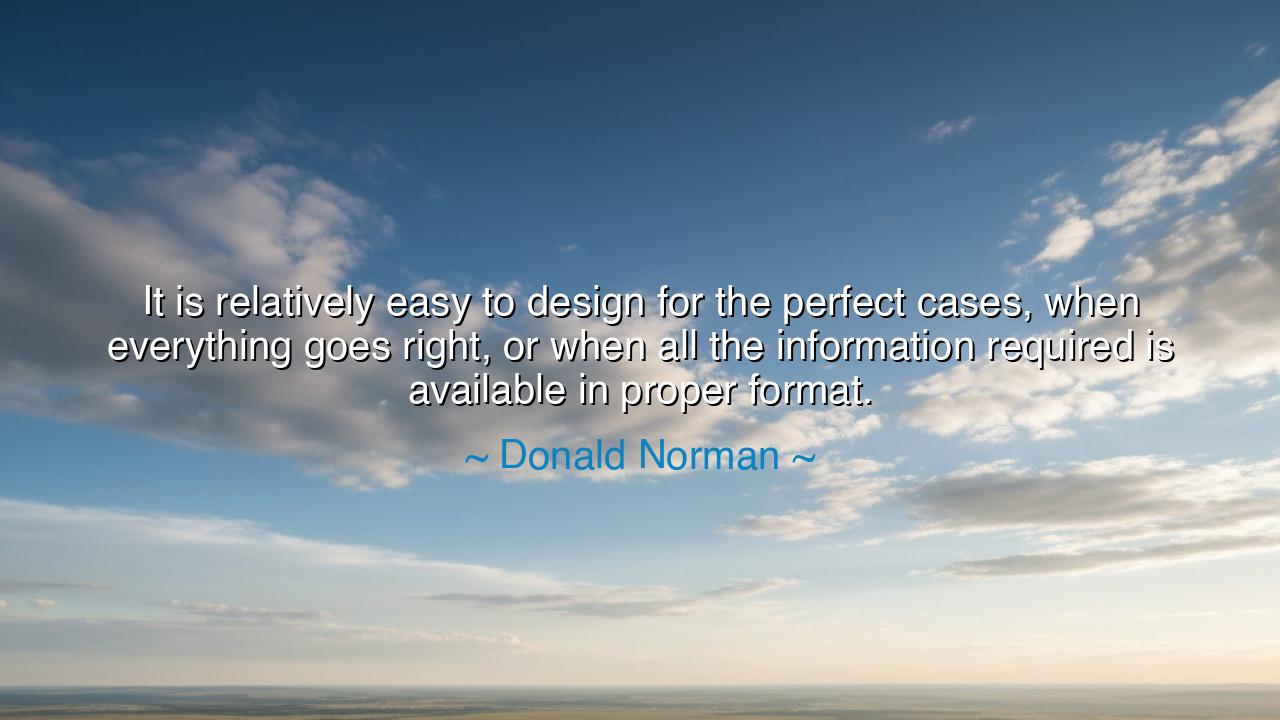
It is relatively easy to design for the perfect cases, when
It is relatively easy to design for the perfect cases, when everything goes right, or when all the information required is available in proper format.






“It is relatively easy to design for the perfect cases, when everything goes right, or when all the information required is available in proper format.” Thus spoke Donald Norman, the wise architect of human-centered design, a thinker who sought not merely to build machines, but to harmonize them with the frailty and brilliance of human nature. His words, though framed in the language of design, carry the depth of a moral truth—that true mastery lies not in crafting for perfection, but in preparing for imperfection. For perfection is a myth, and life, like all human endeavor, unfolds in the realm of error, uncertainty, and incomplete knowledge.
In the age of the ancients, this principle was known not by the name of “design,” but as the art of foresight. The builders of old, from the architects of Egypt to the engineers of Rome, understood that greatness was not achieved by erecting perfect monuments under perfect skies, but by ensuring those monuments endured the storms. The Bridge of Alcántara in Spain still stands after two thousand years not because it was designed for ideal conditions, but because its makers respected the unpredictable—flood, wind, time, and human wear. Norman’s insight draws from the same eternal truth: that to design well, one must first embrace imperfection as the natural state of existence.
Donald Norman, a pioneer of cognitive design, saw in human error not failure but revelation. He observed that most designs falter not because of poor materials or weak aesthetics, but because their creators assume a world where people behave flawlessly, where systems never fail, and where every variable aligns. Yet reality, he reminds us, is never so kind. The designer who builds only for the perfect case builds for a world that does not exist. The wise designer, however, anticipates confusion, misstep, and accident—and through that humility creates designs that serve humanity, not ideality.
Consider the tragic tale of the Space Shuttle Challenger in 1986. Its design, elegant and powerful, assumed conditions that would hold true: the O-rings sealing the rocket boosters would perform as expected. But in the cold air of that January morning, nature betrayed the assumption. The rings failed, and with them, seven lives were lost. The flaw was not in the courage of the astronauts nor in the concept of the shuttle, but in the blind trust in ideal conditions. Norman’s words echo across that moment in history—reminding us that in every system, every creation, the unplanned and imperfect must be respected as fiercely as the intended and perfect.
The ancients would call this wisdom designing for failure—an act not of pessimism, but of reverence. For to expect imperfection is to honor the real, to bow before the unpredictable forces that shape human life. The sculptor leaves room for fracture; the sailor accounts for the storm; the philosopher admits the limits of reason. Likewise, the designer must prepare for the user’s confusion, the system’s delay, the missing data, the unforeseen event. Only then does the creation live not as a fragile construct of control, but as a resilient organism capable of surviving chaos.
Yet there is a deeper layer in Norman’s teaching: it is not only systems and machines that must be designed with imperfection in mind, but people themselves. Leadership, education, and relationships—all crumble when built on expectations of perfection. To “design” for human life is to understand that compassion, forgiveness, and patience are as essential as precision. The wise teacher plans not only for the student who excels, but for the one who struggles. The just leader prepares not only for the day of victory, but for the day of failure. The creator who holds this truth in the heart becomes not a designer of objects, but a designer of understanding.
So let this lesson be passed down to all who build, in any age or art: do not design for the ideal, but for the real. Welcome error as a teacher, and uncertainty as your collaborator. When you create, ask not, “Will this work when all goes right?” but rather, “Will this endure when all goes wrong?” For resilience, not perfection, is the true measure of greatness.
And remember, as Donald Norman teaches, that every act of creation mirrors life itself: unpredictable, imperfect, yet endlessly full of possibility. To design for the perfect case is to dream; to design for the imperfect is to honor the human condition. And in that honor lies the highest form of wisdom—the kind that builds not for gods, but for the hearts and hands of humankind.






AAdministratorAdministrator
Welcome, honored guests. Please leave a comment, we will respond soon